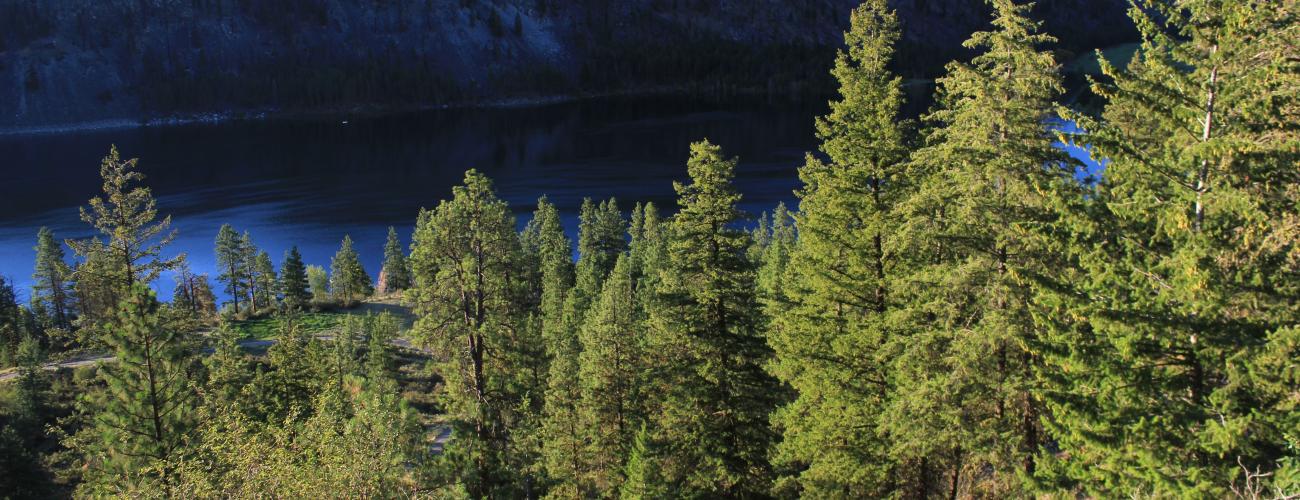Alta Lake State Park History
Alta Lake State Park is located on the shores of an unusual body of water. Its namesake lake, perched 1,166 feet above sea level inside a meandering trench between the Methow and Chelan valleys, has no visible inlet or outlet.
Carved by Ice and Rushing Water
Pioneering geologist J Harlen Bretz opened the door to understanding the story of Alta Lake with his careful observations and mapping of similar “coulees” in Central Washington. “These remarkable records of running water…cannot be interpreted in terms of ordinary river action and ordinary valley development,” he wrote. At the maximum extent of the most recent ice age, the Okanogan Lobe, a tongue of the continental ice cap, flowed over the area of Alta Lake, carving a trench. As the climate warmed at the end of the ice age, massive floods of meltwater from the Okanogan Lobe surged through Alta Coulee, mixed with blocks of ice and sediment, scouring the coulee to create the lake and topography we see today.
Indigenous Lands
Alta Lake lies within the traditional territories of Indigenous people whose present-day descendants include members of the Methow Band of the Confederated Tribes of the Colville Reservation and the Confederated Tribes and Bands of the Yakama Nation. For thousands of years these foothills of the Cascade Mountains and the rivers that flow through them have provided habitat for a diverse community of life that forms the basis of their cultures.
Some members of the tribes occupying this area were not represented at the Walla Walla Treaty Council held by Territorial Governor Isaac Stevens on June 9, 1855. Subsequently, an Executive Order of President Rutherford B. Hayes on April 18, 1879, created the Columbia (or “Moses”) Reservation, roughly covering the same area as today’s Okanogan County west of the Okanogan River extending southwest to the north shore of Lake Chelan. Non-tribal miners living in the area protested the order. On July 4, 1884, the reservation was dissolved, and the land returned to the public domain of the US federal government. On May 1, 1886, the area was formally opened for settlement. Tribal heads of households who wished to remain in the area were allotted up to 640 acres of land. Forty allotments were issued, covering about 25,000 acres.
Most of the land in today’s Alta Lake State Park was included in Indian Allotment No. 24 issued to “Captain Joe” Neekowit, a chief of the Methow Band, in 1884. On January 28, 1924, the town of Pateros purchased 150 acres of the allotment for a city park, requiring the approval of President Calvin Coolidge.
Becoming a State Park
On March 15, 1951, Governor Arthur B. Langlie approved House Bill 204 which authorized the Washington State Parks and Recreation Commission (WSPRC) to accept a gift of land from the town of Pateros and acquire additional land to establish Alta Lake State Park. The transaction was completed on October 1, 1951. The development of park facilities was completed in the early 1960’s.
Keeping the Forest Healthy
Alta Lake’s unusual plumbing (no outlet or inlet) results in fluctuations in the water level tied to climatic changes. In the 1960s, lake levels dropped, spurring park managers to search for methods to supply additional water to the lake. In the early 1980s, the opposite situation arose, when lake waters flooded forested areas near the lakeshore. Pine engraver beetles (Ips pini) colonized trees weakened by the flooding.
Adult male pine engraver beetles bore into the inner bark of trees to excavate a “nuptial chamber” where they are joined by 2-3 females. After mating, each female constructs an egg gallery radiating from the nuptial chamber, laying eggs along the edge. The hatched larvae mine away from the gallery and emerge from the tree in about 10 days to colonize other dead or weakened trees. By the fall of 1984 more than 600 trees in the park had been damaged by the beetles. To protect park visitors and contain the beetles, many trees were removed by park staff, dramatically changing the appearance of the campground.
Fire
Wildland fire is an ever-present feature of the landscape at Alta Lake State Park. In past centuries, forests and grasslands at Alta Lake burned repeatedly every decade or two, sometimes due to fires set by Indigenous people as part of their stewardship of the land. After each fire, a process of ecological succession occurred, shifting the forest community toward shade-tolerant species and increased density until the next fire. Widespread fire suppression policies interrupted this cycle and allowed the forest to become dominated by thick stands of shade-tolerant trees. The altered forest was prone to insect infestations and disease, and its density put it at high risk of a large, uncontrollable fire.
The Carlton Complex Fire started as four small blazes separated by more than 15 miles on July 14, 2014. Three days later, separate fires had merged, covering more than 7,000 acres and spurring evacuation orders for hundreds of residents and the campers at Alta Lake. By the end of that day, the fire's footprint had mushroomed to 167,712 acres. Flaming whirlwinds carried burning material aloft to start spot fires up to a half mile away. By evening, the fire had swept into the town of Pateros, burning 30 homes there and 40 more near Alta Lake State Park, and burning to the edges of the park campground. By July 21 a fire crew of more than 1,600 people had begun the slow process of containing and mopping up the blaze. Full containment was achieved with the help of torrential rains on August 24th.
Following the fire and recovery, the forest has once again begun the process of ecological succession. The peaceful scene that greets visitors coming to camp, hike, fish or swim at the park contrasts with the dramatic events that have taken place over the years.
Sharing the histories of Washington’s state parks is an ongoing project. Learn more here.

